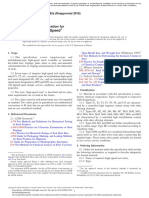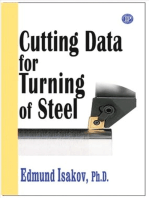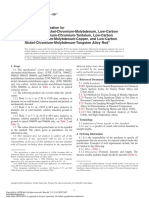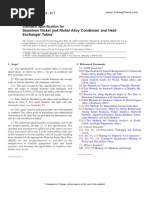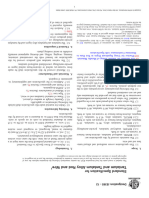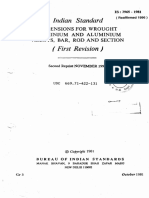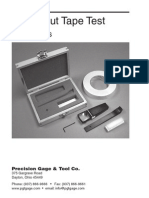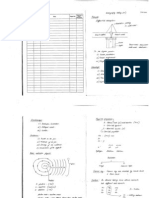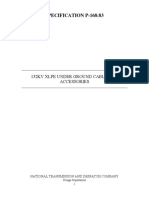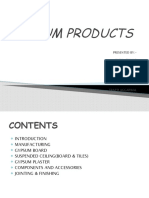SB 333
SB 333
Uploaded by
Yuvaraj SathishCopyright:
Available Formats
SB 333
SB 333
Uploaded by
Yuvaraj SathishOriginal Title
Copyright
Available Formats
Share this document
Did you find this document useful?
Is this content inappropriate?
Copyright:
Available Formats
SB 333
SB 333
Uploaded by
Yuvaraj SathishCopyright:
Available Formats
SPECIFICATION FOR NICKEL-MOLYBDENUM
ALLOY PLATE, SHEET, AND STRIP
SB-333
(Identical with ASTM Specification B 333-95a except that certification has been made mandatory.)
1. Scope E 354 Test Methods for Chemical Analysis of High-
Temperature, Electrical, Magnetic, and Other Similar
1.1 This specification covers plate, sheet, and strip
Iron, Nickel, and Cobalt Alloys
of nickel-molybdenum alloys (UNS N10001, N10665,
N10675, and N10629) as shown in Table 1, for use
in general corrosive service.
3. Terminology
1.2 The following products are covered under this
specification: 3.1 Descriptions of Terms Specific to This Standard:
3.1.1 cold-rolled plate — material 3⁄16 to 3⁄8 in.
1.2.1 Sheet and Strip — Hot or cold rolled, (4.76 to 9.52 mm), inclusive, in thickness.
solution annealed, and descaled unless solution anneal
is performed in an atmosphere yielding a bright finish. 3.1.2 hot-rolled plate — material 3⁄16 in. (4.76
mm) and over in thickness.
1.2.2 Plate — Hot or cold rolled, solution annealed,
and descaled. 3.1.3 plate — material 3⁄16 in. (4.76 mm) and over
in thickness.
1.3 The values stated in inch-pound units are to be
3.1.4 sheet and strip — material under 3⁄16 in.
regarded as the standard. The values given in parentheses
(4.76 mm) in thickness.
are for information only.
4. Ordering Information
2. Referenced Documents 4.1 Orders for material under this specification shall
2.1 ASTM Standards: include the following information:
E 8 Test Methods for Tension Testing of Metallic Mate-
4.1.1 Alloy — Table 1,
rials
E 18 Test Methods for Rockwell Hardness and Rockwell 4.1.2 Dimensions — Thickness (in decimals of an
Superficial Hardness of Metallic Materials inch), width, and length (inch or fractions of an inch),
E 29 Practice for Using Significant Digits in Test Data
to Determine Conformance With Specifications 4.1.3 Optional Requirement — Plate; how the plate
E 55 Practice for Sampling Wrought Nonferrous Metals is to be cut (see 7.8.1 and Table 7),
and Alloys for Determination of Chemical Compo- 4.1.4 Certification — Certification and a report of
sition test results are required (Section 15),
E 112 Test Methods for Determining the Average
Grain Size 4.1.5 Purchase Inspection — State which tests or
E 140 Hardness Conversion Tables for Metals inspections are to be witnessed (Section 13), and
404
COPYRIGHT American Society of Mechanical Engineers
Licensed by Information Handling Services
PART B — NONFERROUS MATERIAL SPECIFICATIONS SB-333
TABLE 1
CHEMICAL REQUIREMENTS
Composition Limits, %
Alloy Alloy Alloy Alloy
Element N10001 N10665 N10675 N10629
Nickel remainderA remainderA 65.0 min remainderA
Molybdenum 26.0–30.0 26.0–30.0 27.0–32.0 26.0–30.0
Iron 4.0–6.0 2.0 max 1.0–3.0 1.0–6.0
Chromium 1.0 max 1.0 max 1.0–3.0 0.5–1.5
Carbon, max 0.05 0.02 0.01 0.01
Silicon, max 1.0 0.10 0.10 0.05
Cobalt, max 2.5 1.00 3.0 2.5
Manganese, max 1.0 1.0 3.0 1.5
Phosphorus, max 0.04 0.04 0.030 0.04
Sulfur, max 0.03 0.03 0.010 0.01
Vanadium 0.2–0.4 ... 0.20 max ...
Nickel plus Molybdenum ... ... 94.0–98.0 ...
Aluminum ... ... 0.50 max 0.1–0.5
Columbium (Nb), max ... ... 0.20 ...
Copper, max ... ... 0.20 0.5
Tantalum, max ... ... 0.20 ...
Titanium, max ... ... 0.20 ...
Tungsten, max ... ... 3.0 ...
Zirconium, max ... ... 0.10 ...
Magnesium, max ... ... ... 0.1
A
See 12.1.1.
4.1.6 Samples for Product (Check) Analysis — Plate 1 of Test Methods E 112. The requirements shall
State whether samples shall be furnished (9.2.2). be as indicated in Table 4.
5. Chemical Composition 7. Dimensions, Mass, and Permissible
Variations
5.1 The material shall conform to the composition
limits specified in Table 1. 7.1 Weight — For calculations of mass or weight,
the following densities shall be used:
5.2 If a product (check) analysis is made by the
purchaser, the material shall conform to the requirements Density
specified in Table 1 subject to the permissible tolerances Alloy lb/in.3 (g/cm3)
in Table 2. N10001 0.334 (9.24)
N10665 0.333 (9.22)
N10675 0.333 (9.22)
N10629 0.333 (9.22)
6. Mechanical Properties and Other
Requirements
7.2 Thickness:
6.1 Tensile Properties — The material shall conform
7.2.1 Plate — The permissible variations in thick-
to the room temperature tensile properties prescribed
ness of plate shall be as prescribed in Table 5.
in Table 3.
7.2.2 Sheet and Strip — The permissible variations
6.2 Hardness — The hardness values given in Table
in thickness of sheet and strip shall be as prescribed
3 are informative only.
in Table 6. The thickness shall be measured with the
6.3 Grain Size for Sheet and Strip — Sheet and micrometer spindle 3⁄8 in. (9.525 mm) or more from
strip shall conform to the grain sizes as illustrated in any edge for material 1 in. (25.4 mm) or over in width
405
COPYRIGHT American Society of Mechanical Engineers
Licensed by Information Handling Services
SB-333 2001 SECTION II
TABLE 2
PRODUCT (CHECK) ANALYSIS TOLERANCES
Tolerances, over max or under min, limit, %
Alloy Alloy Alloy Alloy
Element N10001 N10665 N10675 N10629
Molybdenum ... ... ... 0.25
under min 0.25 0.25 0.25 ...
over max 0.25 0.25 0.35 ...
Iron, under min 0.07 ... 0.05 0.05
over max 0.10 0.05 0.07 0.10
Chromium 0.05 0.05 0.10 ...
under min ... ... ... 0.05
over max ... ... ... 0.10
Carbon 0.01 0.005 0.005 0.005
Silicon 0.05 0.02 0.02 0.01
Cobalt 0.05 0.03 0.05 0.05
Manganese 0.03 0.03 0.04 0.04
Phosphorus 0.005 0.005 0.005 0.005
Sulfur 0.005 0.005 0.003 0.003
Vanadium, under min 0.02 ... ... ...
over max 0.04 ... 0.04 ...
Nickel, under min ... ... 0.45 ...
Aluminum ... ... 0.05 ...
under min ... ... ... 0.02
over max ... ... ... 0.05
Columbium (Nb) + Tantalum ... ... 0.05 ...
Copper ... ... 0.02 0.03
Titanium ... ... 0.03 ...
Tungsten ... ... 0.10 ...
Zirconium ... ... 0.01 ...
Magnesium ... ... ... 0.01
TABLE 3
MECHANICAL PROPERTY REQUIREMENTS
Elongation
in 2 in.
Yield Strength (50.8 mm) Rockwell
Thickness, Tensile Strength, (0.2 % Offset), or 4D A Hardness,B
Alloy in. (mm) min, psi (MPa) min, psi (MPa) min, % max
Sheet and Strip
3
N10001 Under ⁄16 (4.76) 115 000 (795) 50 000 (345) 45 100 HRB
3
N10665 Under ⁄16 (4.76) 110 000 (760) 51 000 (350) 40 100 HRB
3
N10675 Under ⁄16 (4.76) 110 000 (760) 51 000 (350) 40 100 HRB
3
N10629 Under ⁄16 (4.76) 110 000 (760) 51 000 (350) 40 100 HRB
Plate
3
N10001 ⁄16 to 21⁄2 in. (4.76 to 63.5 mm), incl 100 000 (690) 45 000 (310) 40 100 HRB
3
N10665 ⁄16 to 21⁄2 in. (4.76 to 63.5 mm), incl 110 000 (760) 51 000 (350) 40 100 HRB
3
N10675 ⁄16 to 21⁄2 in. (4.76 to 63.5 mm), incl 110 000 (760) 51 000 (350) 40 100 HRB
3
N10629 ⁄16 to 21⁄2 in. (4.76 to 63.5 mm), incl 110 000 (760) 51 000 (350) 40 100 HRB
A
D refers to the diameter of the tension specimen.
B
Hardness values are shown for information purposes only and are not to be used as a basis for rejection or acceptance. For approximate
hardness conversions, see Hardness Conversion Tables E 140.
406
COPYRIGHT American Society of Mechanical Engineers
Licensed by Information Handling Services
PART B — NONFERROUS MATERIAL SPECIFICATIONS SB-333
TABLE 4 (1.27 mm) multiplied by the length in feet or 0.04
GRAIN SIZE FOR ANNEALED SHEET mm multiplied by the length in centimetres.
ASTM Micrograin Average Grain
7.5.2 Straightness for coiled strip is subject to
Thickness, Size Number, Diameter, max,
in. (mm) max mm (in.) agreement between the manufacturer and the purchaser.
0.125 (3.175) and under 3.0 0.127 (0.0050) 7.6 Squareness (Sheet) — For sheets of all thicknesses
Over 0.125 (3.175) 1.5 0.214 (0.0084) and widths of 6 in. (152.4 mm) or more, the angle
between adjacent sides shall be 90 ± 0.15 degrees (1⁄16
in. in 24 in. or 2.6 mm /m).
7.7 Flatness — Plate, sheet, and strip shall be
and at any place on material under 1 in. (25.4 mm) commercially flat.
in width.
7.8 Edges:
7.3 Width: 7.8.1 Plates shall have sheared, abrasive cut, or
7.3.1 Plate — The permissible variations in width plasma-torch-cut edges as specified.
of rectangular plates shall be as prescribed in Table 7.
7.8.2 Sheet and strip shall have sheared or slit
7.3.2 Sheet and Strip — The permissible variations edges.
in width for sheet and strip shall be as prescribed in
Table 8.
7.4 Length: 8. Workmanship, Finish, and Appearance
7.4.1 Plate — Permissible variations in the length 8.1 The material shall be uniform in quality and
of rectangular plate shall be as prescribed in Table 7. condition, smooth and free of injurious imperfections.
7.4.2 Sheet and Strip — Sheet and strip may be
ordered to cut lengths, in which case a variation of
1
⁄8 in. (3.175 mm) over the specified length shall be 9. Sampling
permitted, with a 0 minus tolerance.
9.1 Lots for Chemical Analysis and Mechanical
7.5 Straightness: Testing:
7.5.1 The edgewise curvature (depth of chord) of 9.1.1 A lot for chemical analysis shall consist of
flat sheet, strip, and plate shall not exceed 0.05 in. one heat.
TABLE 5
PERMISSIBLE VARIATIONS IN THICKNESS OF PLATEA
Permissible Variations in Thickness,
in. (mm)B,C
Specified Thickness,
in. (mm) + −
3
⁄16 to 7⁄32 (4.762 to 5.556), incl 0.021 (0.53) 0.010 (0.25)
Over 7⁄32 to 1⁄4 (5.556 to 6.350), incl 0.024 (0.61) 0.010 (0.25)
Over 1⁄4 to 3⁄8 (6.350 to 9.525), incl 0.027 (0.69) 0.010 (0.25)
Over 3⁄8 to 1⁄2 (9.525 to 12.70), incl 0.030 (0.76) 0.010 (0.25)
Over 1⁄2 to 5⁄8 (12.70 to 15.88), incl 0.035 (0.89) 0.010 (0.25)
Over 5⁄8 to 3⁄4 (15.88 to 19.05), incl 0.040 (1.02) 0.010 (0.25)
Over 3⁄4 to 7⁄8 (19.05 to 22.25), incl 0.045 (1.14) 0.010 (0.25)
Over 7⁄8 to 1 (22.25 to 25.4), incl 0.050 (1.27) 0.010 (0.25)
Over 1 to 21⁄2 (25.4 to 63.5), incl 5D 0.010 (0.25)
A
Applicable to plate 48 in. (1.22 m) and under in width.
B
Measured 3⁄8 in. (9.525 mm) or more from any edge.
C
Buffing or grinding for removal of light surface imperfections shall be permitted. The depth of such buffed
or ground areas shall not exceed the minimum tolerance thickness.
D
Expressed as percent of thickness.
407
COPYRIGHT American Society of Mechanical Engineers
Licensed by Information Handling Services
SB-333 2001 SECTION II
TABLE 6
PERMISSIBLE VARIATIONS IN THICKNESS OF SHEET AND STRIPA
Permissible Variations in
Thickness, in. (mm)
(All Widths)B,C
Specified Thickness,
in. (mm) + −
0.020 to 0.034 (0.51 to 0.86), incl 0.004 (0.10) 0.004 (0.10)
Over 0.034 to 0.056 (0.86 to 1.42), incl 0.005 (0.13) 0.005 (0.13)
Over 0.056 to 0.070 (1.42 to 1.78), incl 0.006 (0.15) 0.006 (0.15)
Over 0.070 to 0.078 (1.78 to 1.98), incl 0.007 (0.18) 0.007 (0.18)
Over 0.078 to 0.093 (1.98 to 2.36), incl 0.008 (0.20) 0.008 (0.20)
Over 0.093 to 0.109 (2.36 to 2.77), incl 0.009 (0.23) 0.009 (0.23)
Over 0.109 to 0.125 (2.77 to 3.18), incl 0.010 (0.25) 0.010 (0.25)
Over 0.125 to 0.140 (3.18 to 3.56), incl 0.013 (0.33) 0.010 (0.25)
Over 0.140 to 0.171 (3.56 to 4.34), incl 0.016 (0.41) 0.010 (0.25)
Over 0.171 to 0.187 (4.34 to 4.75), incl 0.018 (0.46) 0.010 (0.25)
A
Applicable to sheet 48 in. (1.22 m) and under in width.
B
Measured 3⁄8 in. (9.525 mm) or more from any edge.
C
Buffing for removal of light surface imperfections shall be permitted. The depth of such buffed areas shall
not exceed the permissible minus variation.
TABLE 7
PERMISSIBLE VARIATIONS IN WIDTH AND LENGTH OF SHEARED, PLASMA
TORCH-CUT, OR ABRASIVE-CUT RECTANGULAR PLATE
Permissible Variations in Widths and Lengths
for Dimensions Given, in. (mm)
Up to 30 (760), incl Over 30 (760)
Specified Thickness + − + −
Inches
Sheared:
3
⁄16 to 5⁄16, excl 3
⁄16 1
⁄8 1
⁄4 1
⁄8
5
⁄16 to 1⁄2, incl 1
⁄4 1
⁄8 3
⁄8 1
⁄8
Abrasive-cut:
3
⁄16 to 11⁄2, incl 1
⁄16 1
⁄16 1
⁄16 1
⁄16
Over 11⁄2 to 21⁄2, incl 1
⁄8 1
⁄8 1
⁄8 1
⁄8
Plasma Torch-Cut:A
3 1 1
⁄16 to 2, excl ⁄2 0 ⁄2 0
5 5
2 to 3, incl ⁄8 0 ⁄8 0
Millimetres
Sheared:
4.76 to 7.94, excl 4.76 3.18 6.35 3.18
7.94 to 12.70, incl 6.35 3.18 9.52 3.18
Abrasive-cut:
4.76 to 38.1, incl 1.59 1.59 1.59 1.59
Over 38.1 to 63.5, incl 3.18 3.18 3.18 3.18
Plasma Torch-Cut:A
4.8 to 50.8, excl 12.7 0 12.7 0
50.8 to 76.2, incl 15.9 0 15.9 0
A
The tolerance spread shown for plasma-torch-cutting may be obtained all on the minus side, or divided
between the plus and minus side if so specified by the purchaser.
408
COPYRIGHT American Society of Mechanical Engineers
Licensed by Information Handling Services
PART B — NONFERROUS MATERIAL SPECIFICATIONS SB-333
TABLE 8
PERMISSIBLE VARIATIONS IN WIDTH OF SHEET AND STRIP
Permissible Variations in Specified
Width, in. (mm)
Specified Thickness, Specified Width,
in. (mm) in. (mm) + −
Sheet
0.137 (4.76) and under 2 (50.8) and over 0.125 (3.18) 0
Strip (Slit Edges)
Over 0.020 to 0.075 (0.51 to 1.90), incl 24 (610) and under 0.007 (0.18) 0.007 (0.18)
Over 0.075 to 0.100 (1.90 to 2.54), incl 24 (610) and under 0.009 (0.23) 0.009 (0.23)
Over 0.100 to 0.125 (2.54 to 3.18), incl 24 (610) and under 0.012 (0.30) 0.012 (0.30)
9.1.2 A lot of plate, sheet, or strip for mechanical 11.2 Tension test specimens shall be any of the
testing shall be defined as the material from one heat standard or subsize specimens shown in Test Methods
in the same condition and specified thickness. E 8.
9.2 Sampling for Chemical Analysis: 11.3 In the event of disagreement, referee specimens
9.2.1 A representative sample shall be obtained shall be as follows:
from each heat during pouring or subsequent processing. 11.3.1 Full thickness of the material, machined to
9.2.2 Product (check) analysis shall be wholly the the form and dimensions shown for the sheet-type
responsibility of the purchaser. specimen in Test Methods E 8 for material under 1⁄2
in. (12.7 mm) in thickness.
9.3 Sampling for Mechanical Testing — Representa-
11.3.2 The largest possible round specimen shown
tive samples shall be taken from each lot of finished
in Test Methods E 8 for material 1⁄2 in. (12.7 mm)
material.
and over.
10. Number of Tests and Retests 12. Test Methods
10.1 Chemical Analysis — One test per heat. 12.1 The chemical composition and mechanical prop-
10.2 Tension Tests — One test per lot. erties of the material as enumerated in this specification
shall be determined, in case of disagreement, in accord-
10.3 Grain Size — One test per lot. ance with the following ASTM standards:
10.4 Retests — If one of the specimens used in the 12.1.1 Chemical Analysis — Test Methods E 354.
above tests of any lot fails to meet the specified For elements not covered by Test Methods E 354, the
requirements, two additional specimens shall be taken referee test method shall be as agreed upon between the
from different sample pieces and tested. The results of manufacturer and the purchaser. The nickel composition
the tests on both of these specimens shall meet the shall be determined arithmetically by difference.
specified requirements. 12.1.2 Tension Test — Test Methods E 8.
12.1.3 Rockwell Hardness Test — Test Methods
E 18.
11. Specimen Preparation
12.1.4 Hardness Conversion — Hardness Conver-
11.1 Tension test specimens shall be taken from
sion Tables E 140.
material in the final condition and tested transverse to
the direction of rolling when width will permit. 12.1.5 Grain Size — Test Methods E 112.
409
COPYRIGHT American Society of Mechanical Engineers
Licensed by Information Handling Services
SB-333 2001 SECTION II
12.1.6 Determining Significant Places — Practice faction with the results of the test, the producer or
E 29. supplier may make claim for a rehearing.
12.1.7 Method of Sampling — Practice E 55.
15. Certification
12.2 For purposes of determining compliance with
the limits in this specification, an observed or calculated 15.1 A manufacturer’s certification shall be furnished
value shall be rounded in accordance with the rounding to the purchaser stating that material has been manufac-
method of Practice E 29: tured, tested, and inspected in accordance with this
specification, and that the test results on representative
Rounded Unit for Observed samples meet specification requirements. A report of
Requirements or Calculated Value
the test results shall be furnished.
Chemical composition and Nearest unit in the last right-
tolerances hand place of figures of the
specified limit 16. Product Marking
Tensile strength and yield Nearest 1000 psi (7 MPa)
strength 16.1 Each plate, sheet, or strip shall be marked on
Elongation Nearest 1% one face with the specification number, alloy, heat
number, manufacturer’s identification, and size. The
markings shall have no deleterious effect on the material
13. Inspection or its performance and shall be sufficiently stable to
withstand normal handling.
13.1 Inspection of the material by the purchaser at
the place of manufacture shall be made as agreed upon 16.2 Each bundle or shipping container shall be
between the purchaser and the manufacturer as part of marked with the name of the material; this specification
the purchase contract. number; alloy; the size; gross, tare, and net weight;
consignor and consignee address; contract or order
number; and such other information as may be defined
in the contract or order.
14. Rejection and Rehearing
14.1 Material tested by the purchaser that fails to
17. Keywords
conform to the requirements of this specification may
be rejected. Rejection should be reported to the producer 17.1 plate; sheet; strip; UNS N10001; UNS N10629;
or supplier promptly and in writing. In case of dissatis- UNS N10665; UNS N10675
410
COPYRIGHT American Society of Mechanical Engineers
Licensed by Information Handling Services
PART B — NONFERROUS MATERIAL SPECIFICATIONS SB-333
APPENDIX
(Nonmandatory Information)
X1. HEAT TREATMENT
X1.1 Proper heat treatment during or subsequent to
fabrication is necessary for optimum performance, and
the manufacturer shall be consulted for details.
411
COPYRIGHT American Society of Mechanical Engineers
Licensed by Information Handling Services
You might also like
- Asme SB-443Document11 pagesAsme SB-443coronado777No ratings yet
- High-Strength Low-Alloy Structural Steel Plate With Low Carbon and Restricted Sulfur For Improved Weldability, Formability, and ToughnessDocument3 pagesHigh-Strength Low-Alloy Structural Steel Plate With Low Carbon and Restricted Sulfur For Improved Weldability, Formability, and ToughnessMarcelo BarretosNo ratings yet
- Tool Steel High Speed: Standard Specification ForDocument13 pagesTool Steel High Speed: Standard Specification Foralucard375100% (1)
- Aditya Birla Epotec Product Catalogue PDFDocument24 pagesAditya Birla Epotec Product Catalogue PDFTirupati Chemical CompanyNo ratings yet
- 22 Metallic Glasses, Dr. T. HufnagelDocument30 pages22 Metallic Glasses, Dr. T. HufnagelSam AkinaNo ratings yet
- SB 335Document6 pagesSB 335Yuvaraj SathishNo ratings yet
- Partb 733Document6 pagesPartb 733mmlingNo ratings yet
- ASTM B 333 Ni-Mo Alloy Plate Sheet & Strip - 1998Document5 pagesASTM B 333 Ni-Mo Alloy Plate Sheet & Strip - 1998ecsuperalNo ratings yet
- Low-Carbon Nickel-Chromium-Molybdenum, Low-Carbon Nickel-Molybdenum-Chromium-Tantalum, Low-Carbon Nickel-Chromium-Molybdenum-Copper, and Low-Carbon Nickel-Chromium-Molybdenum-Tungsten Alloy RodDocument4 pagesLow-Carbon Nickel-Chromium-Molybdenum, Low-Carbon Nickel-Molybdenum-Chromium-Tantalum, Low-Carbon Nickel-Chromium-Molybdenum-Copper, and Low-Carbon Nickel-Chromium-Molybdenum-Tungsten Alloy RodiyamNo ratings yet
- PDFsam - B 386 - 03 (2011)Document5 pagesPDFsam - B 386 - 03 (2011)mike.jensen0581No ratings yet
- Specification For Precipitation-Hardening Nickel Alloy Bars, Forgings, and Forging Stock For High-Temperature ServiceDocument9 pagesSpecification For Precipitation-Hardening Nickel Alloy Bars, Forgings, and Forging Stock For High-Temperature ServicerbagriNo ratings yet
- ASTM B574 - 2006e1Document4 pagesASTM B574 - 2006e1Cesar ParadaNo ratings yet
- PDFsam - B 463 - 10 (2016)Document2 pagesPDFsam - B 463 - 10 (2016)mike.jensen0581No ratings yet
- Astm B575Document5 pagesAstm B575Jota Jacques100% (1)
- SB 690Document6 pagesSB 690Yuvaraj SathishNo ratings yet
- Asme B 446Document5 pagesAsme B 446Ramon AraujoNo ratings yet
- PDFsam - B 393 - 09e1Document6 pagesPDFsam - B 393 - 09e1mike.jensen0581No ratings yet
- Astm B333Document5 pagesAstm B333Jota JacquesNo ratings yet
- Unalloyed Titanium, For Surgical Implant Applications (UNS R50250, UNS R50400, UNS R50550, UNS R50700)Document5 pagesUnalloyed Titanium, For Surgical Implant Applications (UNS R50250, UNS R50400, UNS R50550, UNS R50700)JoãoNo ratings yet
- Astm B163Document13 pagesAstm B163Ramón GarcíaNo ratings yet
- SB 691Document8 pagesSB 691Yuvaraj SathishNo ratings yet
- Astm B443Document8 pagesAstm B443HoangNo ratings yet
- B 367 - 93 R98 Qjm2ny05m1i5oaDocument5 pagesB 367 - 93 R98 Qjm2ny05m1i5oaHéctor NossaNo ratings yet
- ASTM A356-98 (Steel Castings)Document12 pagesASTM A356-98 (Steel Castings)murthyNo ratings yet
- UNS N08020, UNS N08024, and UNS N08026 Nickel Alloy Bar and WireDocument6 pagesUNS N08020, UNS N08024, and UNS N08026 Nickel Alloy Bar and WireJeje KwonNo ratings yet
- PDFsam - B 443 - 00 (2014)Document7 pagesPDFsam - B 443 - 00 (2014)mike.jensen0581No ratings yet
- SB 688Document9 pagesSB 688Yuvaraj SathishNo ratings yet
- Specification For Copper-Nickel-Zinc Alloy (Nickel Silver) and Copper-Nickel Rod and BARDocument6 pagesSpecification For Copper-Nickel-Zinc Alloy (Nickel Silver) and Copper-Nickel Rod and BARRetract11No ratings yet
- PDFsam - B 446 - 03 (2014)Document5 pagesPDFsam - B 446 - 03 (2014)mike.jensen0581No ratings yet
- Astm (B443)Document7 pagesAstm (B443)Marcos AndradeNo ratings yet
- ASTM-F136-titaniumDocument4 pagesASTM-F136-titaniumgholami14638No ratings yet
- A732A732MDocument6 pagesA732A732MAnderson TadeuNo ratings yet
- Astm A 283M-00 PDFDocument2 pagesAstm A 283M-00 PDFMemelas FerMaxNo ratings yet
- UNS N06002, UNS N06230, UNS N12160, and UNS R30556 Plate, Sheet, and StripDocument3 pagesUNS N06002, UNS N06230, UNS N12160, and UNS R30556 Plate, Sheet, and StripLemir LopezNo ratings yet
- Astm A333Document8 pagesAstm A333DilaFirizqinaNo ratings yet
- Unalloyed Titanium, For Surgical Implant Applications (UNS R50250, UNS R50400, UNS R50550, UNS R50700)Document4 pagesUnalloyed Titanium, For Surgical Implant Applications (UNS R50250, UNS R50400, UNS R50550, UNS R50700)RazieNo ratings yet
- B 865 - 96 - Qjg2ns1sruqDocument10 pagesB 865 - 96 - Qjg2ns1sruqjudzvasquezNo ratings yet
- Nickel-Chromium-Silicon Alloy (UNS N08330) Billets and Bars: Standard Specification ForDocument2 pagesNickel-Chromium-Silicon Alloy (UNS N08330) Billets and Bars: Standard Specification ForLemir LopezNo ratings yet
- B29 - 03 ISO StandDocument3 pagesB29 - 03 ISO StandRizwanNo ratings yet
- B 150 - B 150m - 02 - Qje1mc9cmtuwts1sruqDocument11 pagesB 150 - B 150m - 02 - Qje1mc9cmtuwts1sruqHimanshu KashyapNo ratings yet
- Steel Joint Bars, Low, Medium, and High Carbon (Non-Heat-Treated)Document3 pagesSteel Joint Bars, Low, Medium, and High Carbon (Non-Heat-Treated)matiullahNo ratings yet
- Nickel-Chromium-Iron-Molybdenum-Copper Alloy Rod: Standard Specification ForDocument4 pagesNickel-Chromium-Iron-Molybdenum-Copper Alloy Rod: Standard Specification ForLemir LopezNo ratings yet
- Seamless and Welded Austenitic Stainless Steel Tubing (Small-Diameter) For General ServiceDocument4 pagesSeamless and Welded Austenitic Stainless Steel Tubing (Small-Diameter) For General ServiceAlejandro GonzálezNo ratings yet
- A608A608MDocument6 pagesA608A608MsiderqualidadeNo ratings yet
- F 1 - 94 R00 - Rjetukve PDFDocument4 pagesF 1 - 94 R00 - Rjetukve PDFYayan RnsNo ratings yet
- Astm B434-2006Document3 pagesAstm B434-2006krishnamoorthy SrinivasanNo ratings yet
- Astm A490m 10Document4 pagesAstm A490m 10ahmed romiehNo ratings yet
- PDFsam - B 365 - 12Document4 pagesPDFsam - B 365 - 12mike.jensen0581No ratings yet
- Nickel-Chromium-Iron Sealing Alloys: Standard Specification ForDocument4 pagesNickel-Chromium-Iron Sealing Alloys: Standard Specification ForRob GridleyNo ratings yet
- SB - 622 PDFDocument10 pagesSB - 622 PDFSamir ChaudharyNo ratings yet
- Chromium and Chromium-Nickel Stainless Steel Plate, Sheet, and Strip For Pressure Vessels and For General ApplicationsDocument3 pagesChromium and Chromium-Nickel Stainless Steel Plate, Sheet, and Strip For Pressure Vessels and For General ApplicationsVi AnNo ratings yet
- B 98 - B 98m - 98 Qjk4l0i5oe0tukveDocument8 pagesB 98 - B 98m - 98 Qjk4l0i5oe0tukvechavezleslyaliNo ratings yet
- Asme Sfa Sa 213Document14 pagesAsme Sfa Sa 213Mayank SinglaNo ratings yet
- Norma Aço Rápido A600Document13 pagesNorma Aço Rápido A600Assis JúniorNo ratings yet
- A 1014 - 02 QtewmtqtukveDocument5 pagesA 1014 - 02 QtewmtqtukveA MahmoodNo ratings yet
- PDFsam - B 392 - 09e1Document4 pagesPDFsam - B 392 - 09e1mike.jensen0581No ratings yet
- Astm B805Document7 pagesAstm B805steve.phillipsNo ratings yet
- F 899 - 02 Surgical SteelDocument8 pagesF 899 - 02 Surgical Steelhafiz munawarNo ratings yet
- Astm B622Document6 pagesAstm B622Ramón GarcíaNo ratings yet
- ASTM B572 -24 (eg.haynes230合金)Document4 pagesASTM B572 -24 (eg.haynes230合金)chundongxNo ratings yet
- SB 861Document9 pagesSB 861Yuvaraj SathishNo ratings yet
- Fillet Weld TestsDocument2 pagesFillet Weld TestsYuvaraj SathishNo ratings yet
- Visual Inspection On Quality of Welds Clause 7.8.1 of AWSDocument1 pageVisual Inspection On Quality of Welds Clause 7.8.1 of AWSYuvaraj SathishNo ratings yet
- Fracture TestDocument1 pageFracture TestYuvaraj Sathish100% (1)
- AWS Welding Inspector ExaminationDocument29 pagesAWS Welding Inspector ExaminationYuvaraj SathishNo ratings yet
- AWS Welding SymbolsDocument11 pagesAWS Welding SymbolsYuvaraj Sathish100% (1)
- ER1100 & ER4043 SpecificationsDocument3 pagesER1100 & ER4043 SpecificationsYuvaraj SathishNo ratings yet
- Design of Welded ConnectionsDocument3 pagesDesign of Welded ConnectionsYuvaraj SathishNo ratings yet
- JIS For Radiographic ExaminationDocument32 pagesJIS For Radiographic ExaminationYuvaraj Sathish0% (1)
- Indian Standard: Methods of Chemical Analysis of Copper (Document32 pagesIndian Standard: Methods of Chemical Analysis of Copper (Yuvaraj SathishNo ratings yet
- BS 6014Document12 pagesBS 6014Yuvaraj SathishNo ratings yet
- Electrical Clearence As Per BS-162Document1 pageElectrical Clearence As Per BS-162Yuvaraj SathishNo ratings yet
- Is 3965 PDFDocument13 pagesIs 3965 PDFYuvaraj SathishNo ratings yet
- Is 1897Document9 pagesIs 1897Yuvaraj SathishNo ratings yet
- Electrical Conductivity and ResistivityDocument3 pagesElectrical Conductivity and ResistivityYuvaraj SathishNo ratings yet
- Guide For WPS PreparationDocument15 pagesGuide For WPS PreparationYuvaraj SathishNo ratings yet
- Centre PunchesDocument1 pageCentre PunchesYuvaraj SathishNo ratings yet
- Cross Cut Kit ManualDocument5 pagesCross Cut Kit ManualYuvaraj Sathish100% (1)
- Radiography Test Course MaterailDocument16 pagesRadiography Test Course MaterailYuvaraj Sathish100% (5)
- Position of Welds ComparisonDocument3 pagesPosition of Welds ComparisonYuvaraj SathishNo ratings yet
- PulverizationDocument26 pagesPulverizationVasantha SudasinghaNo ratings yet
- Compair 2-Seiter Ca Oil enDocument2 pagesCompair 2-Seiter Ca Oil enzubairNo ratings yet
- TDS - GypEX Silver PlasterDocument4 pagesTDS - GypEX Silver Plastersuyog kattelNo ratings yet
- Casting Defects - Sand Mold, Metal CastingDocument11 pagesCasting Defects - Sand Mold, Metal CastingAlok NayakNo ratings yet
- CD 533 Determination of Pipe and Bedding Combinations For Drainage Works-WebDocument27 pagesCD 533 Determination of Pipe and Bedding Combinations For Drainage Works-WebBalaji NaikNo ratings yet
- Influence of Hardening Accelerating Admixtures On Properties of Cement With Ground Granulated Blast Furnace SlagDocument6 pagesInfluence of Hardening Accelerating Admixtures On Properties of Cement With Ground Granulated Blast Furnace SlagLider Ricardo Alarcon CardenasNo ratings yet
- 25CrMo4 (EN 10083 3)Document2 pages25CrMo4 (EN 10083 3)mohsen_267100% (1)
- Prima D839Document6 pagesPrima D839chicoetenacNo ratings yet
- ANNEX 8 - Bill of Quantities For HVACDocument40 pagesANNEX 8 - Bill of Quantities For HVACUdy PriyonoNo ratings yet
- EutecTrode 3055Document2 pagesEutecTrode 3055asmaa aliNo ratings yet
- Front View Section A-A C ADocument4 pagesFront View Section A-A C Adarwish.hiltiNo ratings yet
- Work Method Statement - BOND IT & Elite 90Document3 pagesWork Method Statement - BOND IT & Elite 90Sathish Gowda0% (1)
- TIE33-Bending Strength of Optical Glass and ZERODUR®Document20 pagesTIE33-Bending Strength of Optical Glass and ZERODUR®侯涛No ratings yet
- Materials Today: Proceedings: Venkata Naga Baji Tokala, Sarat Babu MulpurDocument6 pagesMaterials Today: Proceedings: Venkata Naga Baji Tokala, Sarat Babu MulpurSARAT BABU MULPURNo ratings yet
- Delrin Mold Guide 11 06Document48 pagesDelrin Mold Guide 11 06ibmufnman100% (2)
- Mechanical Testing of MaterialsDocument6 pagesMechanical Testing of MaterialsAbhijeet P. DashNo ratings yet
- Ground Slab CourseDocument36 pagesGround Slab CoursezainalharrisNo ratings yet
- Datasheet ASUDocument1 pageDatasheet ASURamon DalisonNo ratings yet
- Fibers and Textile Englisch M 252 Nzing Chemie GMBHDocument32 pagesFibers and Textile Englisch M 252 Nzing Chemie GMBHDewiNo ratings yet
- Brake L Specification Text Brake Leur ADocument3 pagesBrake L Specification Text Brake Leur AhjduarteNo ratings yet
- p-168-83 - U.ground CableDocument17 pagesp-168-83 - U.ground CablesohaibNo ratings yet
- Al Rostamani Mix Design Compliance SheetDocument6 pagesAl Rostamani Mix Design Compliance SheetOMAR MUKTHAR JAMAL MOHAMEDNo ratings yet
- An Appraisal of Certain Factors Which Influence Toughness Restoration (De-Embrittlement) in Some Temper Embrittled Low Alloy SteelsDocument17 pagesAn Appraisal of Certain Factors Which Influence Toughness Restoration (De-Embrittlement) in Some Temper Embrittled Low Alloy SteelssajawalNo ratings yet
- Degradation of PVCDocument29 pagesDegradation of PVCChakma SHIMULNo ratings yet
- Gypsum Products: Presented By:-Sneha Tomar Shalini Negi Swikriti Gupta Sonia Trapti AggarwalDocument19 pagesGypsum Products: Presented By:-Sneha Tomar Shalini Negi Swikriti Gupta Sonia Trapti AggarwalRUSHALI SRIVASTAVANo ratings yet
- Structural Assignment 2Document21 pagesStructural Assignment 2Praveen FernandoNo ratings yet
- Boq 671963Document7 pagesBoq 671963Rahul GaurNo ratings yet
- How To Make Glass (With Pictures) - WikihowDocument11 pagesHow To Make Glass (With Pictures) - WikihowAustin JosephNo ratings yet


